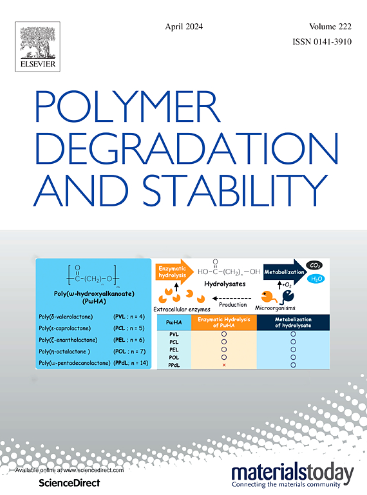Halopseudomonas sp. MFKK-1: A marine-derived bacterium capable of degrading poly(butylene succinate-co-adipate), poly(ε-caprolactone), and poly(butylene adipate-co-terephthalate) in marine ecosystems
IF 6.3
2区 化学
Q1 POLYMER SCIENCE
引用次数: 0
Abstract
Aliphatic and aliphatic-aromatic polyesters are potentially biodegradable polymers that have garnered attention as promising solutions to plastic waste menace, particularly in marine environments. Among these, poly(butylene succinate-co-adipate) (PBSA), which has polyethylene-like properties, is used as biodegradable packaging and mulch film. However, the slow degradation of PBSA in marine environments presents a challenge. We isolated a polyester-degrading bacterium, MFKK-1, from seawater collected from a quay and investigated its PBSA degradation potential in the marine environment. The isolate, identified as a member of the genus Halopseudomonas, demonstrated PBSA degradation potential at the salinity levels of seawater. In addition to PBSA, the strain could degrade poly(ε-caprolactone) (PCL) and the aliphatic-aromatic polyester poly(butylene adipate-co-terephthalate) (PBAT). The strain used 1,4-butanediol and adipate, monomeric components of PBSA, as carbon sources for growth. Moreover, the gene aphHsp, responsible for the degradation of polyesters, was heterologously expressed in Escherichia coli. The purified recombinant APHHsp was characterized. This enzyme belongs to the α/β hydrolase family, with a catalytic triad composed of Ser171, Asp217, and His249. It is a mesophilic enzyme that has shown the ability to degrade PBSA, PCL, and PBAT films in buffer supplemented with 0.5 M NaCl, a salinity comparable to that of seawater. Furthermore, the enzyme degraded amorphous poly(ethylene terephthalate) under 0.5 M NaCl conditions. The findings of this study enhance our knowledge of the microbial degradation of polyesters in marine environments, potentially supporting the sustainable application of biodegradable materials in ocean ecosystems.

Halopseudomonas sp. MFKK-1:一种能够降解海洋生态系统中的聚琥珀酸丁二醇酯、聚ε-己内酯和聚对苯二甲酸丁二醇酯的海洋源细菌
本文章由计算机程序翻译,如有差异,请以英文原文为准。
求助全文
约1分钟内获得全文
求助全文
来源期刊

Polymer Degradation and Stability
化学-高分子科学
CiteScore
10.10
自引率
10.20%
发文量
325
审稿时长
23 days
期刊介绍:
Polymer Degradation and Stability deals with the degradation reactions and their control which are a major preoccupation of practitioners of the many and diverse aspects of modern polymer technology.
Deteriorative reactions occur during processing, when polymers are subjected to heat, oxygen and mechanical stress, and during the useful life of the materials when oxygen and sunlight are the most important degradative agencies. In more specialised applications, degradation may be induced by high energy radiation, ozone, atmospheric pollutants, mechanical stress, biological action, hydrolysis and many other influences. The mechanisms of these reactions and stabilisation processes must be understood if the technology and application of polymers are to continue to advance. The reporting of investigations of this kind is therefore a major function of this journal.
However there are also new developments in polymer technology in which degradation processes find positive applications. For example, photodegradable plastics are now available, the recycling of polymeric products will become increasingly important, degradation and combustion studies are involved in the definition of the fire hazards which are associated with polymeric materials and the microelectronics industry is vitally dependent upon polymer degradation in the manufacture of its circuitry. Polymer properties may also be improved by processes like curing and grafting, the chemistry of which can be closely related to that which causes physical deterioration in other circumstances.
 求助内容:
求助内容: 应助结果提醒方式:
应助结果提醒方式:


